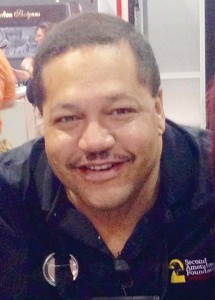by Richard Smith | SAFTD Program Director
 A bit of an introduction and background information is in order, so as to put the rest of this article in context. My name is Richard Smith and I am a full time Firearms Instructor. I am fully licensed by my state (Florida “K” license) and certified by a wide variety of organizations such as SAFTD, Rangemaster, IALEFI, NRA Law Enforcement, and more. A brief resume can be found at FTAguns.com.
A bit of an introduction and background information is in order, so as to put the rest of this article in context. My name is Richard Smith and I am a full time Firearms Instructor. I am fully licensed by my state (Florida “K” license) and certified by a wide variety of organizations such as SAFTD, Rangemaster, IALEFI, NRA Law Enforcement, and more. A brief resume can be found at FTAguns.com.
I consider myself a full time student of the art of the gun, and I usually take 40+ hours of firearms courses a year as a student to help keep me fresh on the subject and to continue growing my own personal skill set. I believe no matter how much you think you know you can always take something away from a good instructor.
Let us examine what effective civilian firearms training is and isn’t, and why it is important for firearm owners.
First, hopefully, nothing in this article is new information to you, but that doesn’t diminish its importance. I’ve learned this information from my own training and various other sources, and here I am compiling key facts for you into one coherent article.
Training with firearms needs to be done in context with the intended use of that particular firearm.
Let us examine military training and firearms usage.
The military primarily uses a long gun and they generally train and work in teams.
For most military members, if they are issued a handgun, it is used as a backup, not a primary weapon.
When a war fighter is engaged on the battlefield, for the most part, he/she does not have to be concerned with legal consequences; they have specific Rules of Engagement and as long as they follow them, they are protected. For example, I have trained many former and current military members, and not one of them has ever expressed concern about being sued by the Taliban.
In military engagements there is typically an “acceptable” casualty rate; on the other hand, there is absolutely no acceptable casualty rate for the defensive-minded civilian.
Military engagements may be offensive or defensive.
The military usually has significant advance intelligence information, such as many hours to several days of surveillance, satellite feeds, drones, etc., to formulate a game plan. The civilian doesn’t have these information sources, nor the luxury of choosing when and where they will be attacked.
The military can call for additional support, unlike the civilian, who is likely going to be on their own.
The military understands and accepts the concept of collateral damage, including casualties among non-combatants. Collateral damage for the civilian usually results in a prison sentence.
There are military tactics, such as “suppressive fire” that would land a civilian behind bars.
The military has excellent training in arms for their intended context. Unfortunately, there is a completely different context of usage for the armed civilian.
Now let us examine the LE training and usage of firearms.
LE may, and sometimes must, be aggressive. The civilian must be defensive minded; defending themselves or someone else is the only legally defendable use of a firearm in a confrontation situation.
The LE mindset is also vastly different than the civilian’s mindset.
LE has access to quick back-up, and the civilian does not.
LE trains in teams like SRT, SWAT, HRT, etc. By contrast, when the civilian is attacked at 10pm in the Walmart parking lot, there is usually no team or back up available. The civilian is on his/her own and must train for such. There is a saying: “when seconds count, the police are only minutes away.”
In the aftermath of an armed encounter, LE has legal help, unions, PBA, FOP, etc. to help them. The civilian has the option to subscribe to legal defense organizations, but they are on their own financially.
I could offer more examples, but hopefully you understand the point about why military or LE experience does not necessarily translate into good training for the civilian.
“Real world” encounters are yet another misunderstood concept. Traditionally less than 3% of Mil/LE are involved in gun play, and they are typically trained by trainers that haven’t experienced live fire, yet somehow they are usually remarkably well trained for combat fire in their particular context. The reason for this is effective mindset training, pure and simple.
Heretofore we have explored the contextual differences between the varied commonly armed population sectors.
So what training does a civilian with a concealed handgun and a license need?
The civilian needs training that addresses the civilian’s “real world” concerns.
Civilian training should address the most typical civilian defensive encounters, proper mindset, situational awareness, and legal considerations, with a concentration on the basics executed well and quickly.
Some additional tips for the armed civilian include:
staying away from unqualified and uncertified instructors, vet any instructor that you choose to train with.
As civilians we should also be aware of certain buzz words that are used to market training, like “tactical,” “combat,” “real world,” etc.



